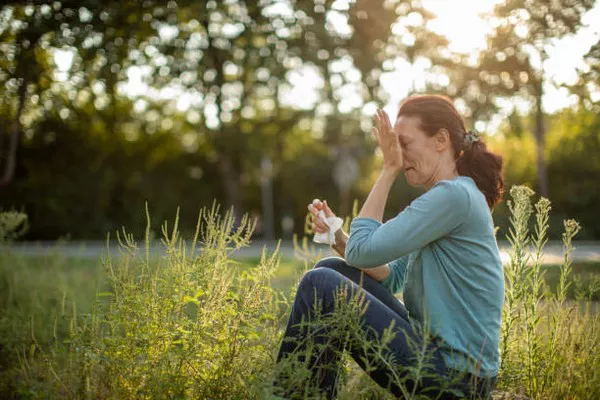Seasonal allergies are a common concern for millions of people each year. Whether it’s the beginning of spring or the crisp arrival of fall, many individuals experience a range of symptoms, from sneezing to itchy eyes and nasal congestion. While both fall and spring allergies can significantly impact your daily life, they are triggered by different allergens and often require distinct management approaches. Understanding the differences between the two can help you take effective steps toward relief.
What Causes Seasonal Allergies?
Seasonal allergies, also known as seasonal allergic rhinitis or hay fever, occur when your immune system overreacts to allergens present in the environment during specific times of the year. Common symptoms include:
Sneezing
Runny or stuffy nose
Itchy eyes, nose, or throat
Watery eyes
Coughing
Fatigue
These symptoms are the body’s response to airborne allergens like pollen or mold spores, which vary depending on the season.
Spring Allergies
What Triggers Spring Allergies?
Spring allergies are primarily caused by tree pollen. As temperatures rise and plants awaken from winter dormancy, trees begin to pollinate, releasing microscopic pollen grains into the air.
Common Spring Allergen Sources
Trees: Oak, birch, maple, cedar, ash, and elm
Grass pollen: Begins in late spring in many regions
Mold: Especially in rainy or humid areas
Pollen levels tend to peak in the morning and during dry, windy days, making outdoor activities more challenging for allergy sufferers.
Symptoms of Spring Allergies
Spring allergies typically manifest as:
Sneezing fits
Nasal congestion
Itchy eyes and nose
Red, watery eyes
Postnasal drip
In some individuals, spring allergies can also trigger allergic asthma, causing wheezing and shortness of breath.
Managing Spring Allergies
Prevention
Monitor pollen forecasts daily
Keep windows closed, especially in the morning
Shower and change clothes after outdoor exposure
Use HEPA filters in your home
Treatment
Antihistamines: Reduce sneezing, itching, and runny nose
Nasal corticosteroids: Decrease inflammation in the nasal passages
Decongestants: Provide temporary relief from nasal swelling
Allergy immunotherapy: Allergy shots or sublingual tablets may help reduce sensitivity over time
Fall Allergies
What Triggers Fall Allergies?
Unlike spring, fall allergies are driven by weed pollen and mold spores. As plants begin to wither and leaves decay, certain allergens become more prevalent in the air.
Common Fall Allergen Sources
Ragweed: The most significant fall allergen in North America
Mold spores: Grow on fallen leaves, compost piles, and in damp indoor areas
Dust mites: May resurface when heating systems are turned on
Ragweed pollen can travel hundreds of miles on the wind, affecting even those in urban environments far from any fields or gardens.
Symptoms of Fall Allergies
Fall allergy symptoms often include:
Sneezing
Nasal congestion
Coughing
Itchy throat and eyes
Dark circles under the eyes
Worsening of asthma symptoms
Mold spores can also trigger more severe respiratory symptoms in sensitive individuals, especially those with mold allergies or asthma.
Managing Fall Allergies
Prevention
Avoid outdoor activities during peak pollen times (midday and afternoon)
Wear a mask while raking leaves or doing yard work
Use dehumidifiers to control indoor moisture
Clean air ducts and replace filters before turning on heating systems
Treatment
Antihistamines and decongestants: Help control symptoms
Nasal sprays: Provide targeted relief
Leukotriene modifiers: Prescription medications that block inflammatory chemicals
Allergy shots: Long-term solution for ragweed or mold allergies
Key Differences Between Fall and Spring Allergies
Although symptoms can be similar, fall and spring allergies differ in their timing, triggers, and environmental conditions.
| Feature | Spring Allergies | Fall Allergies |
|---|---|---|
| Main Allergens | Tree and grass pollen | Ragweed pollen and mold spores |
| Onset | March to early June | Late August to November |
| Peak Pollen Times | Early morning | Midday to afternoon |
| Weather Triggers | Windy and dry days | Damp and decaying plant matter |
| Asthma Risk | Moderate | Often higher due to mold spores |
Understanding these distinctions can help individuals tailor their allergy prevention and treatment strategies more effectively.
Shared Allergy Management Tips
While triggers may differ, there are universal strategies that can help reduce allergy symptoms year-round:
Lifestyle Adjustments
Track pollen and mold counts in your area
Wash your hands and face frequently
Use a saline nasal rinse to clear allergens from nasal passages
Change air filters regularly in your home and car
Vacuum with a HEPA filter to reduce indoor allergens
Medical Treatments
If over-the-counter medications aren’t effective, consult a healthcare provider or allergist. They may recommend:
Prescription antihistamines
Combination therapy (e.g., nasal spray plus antihistamine)
Allergy testing to identify specific triggers
Allergy immunotherapy for long-term relief
Children and Seasonal Allergies
Children are especially vulnerable to seasonal allergies, and symptoms can affect their mood, sleep, and school performance. Watch for signs like:
Frequent nose rubbing or throat clearing
Itchy eyes
Difficulty sleeping
Daytime fatigue
Speak to a pediatrician about safe and age-appropriate allergy treatments. In some cases, starting allergy medications before the season begins can help reduce symptoms.
When to See a Doctor
If seasonal allergies are severely affecting your quality of life or triggering asthma symptoms, it’s time to consult a specialist. Seek medical advice if you experience:
Persistent or worsening symptoms
Frequent sinus infections
Shortness of breath or wheezing
Difficulty sleeping due to congestion or coughing
An allergist can perform tests to identify your specific triggers and help create a personalized treatment plan.
Conclusion
Both fall and spring allergies can be uncomfortable and disruptive, but they stem from different environmental allergens. While spring allergies are mainly due to tree and grass pollen, fall allergies are driven by ragweed and mold spores. By understanding the distinctions between the two seasons, you can better prepare, treat, and prevent symptoms year-round.
Whether you’re sniffling through spring blooms or sneezing at autumn leaves, proactive management—through lifestyle changes, medications, and allergy testing—can offer significant relief. Don’t let seasonal allergies control your life; with the right strategies, you can enjoy every season symptom-free.
You Might Be Interested In:

